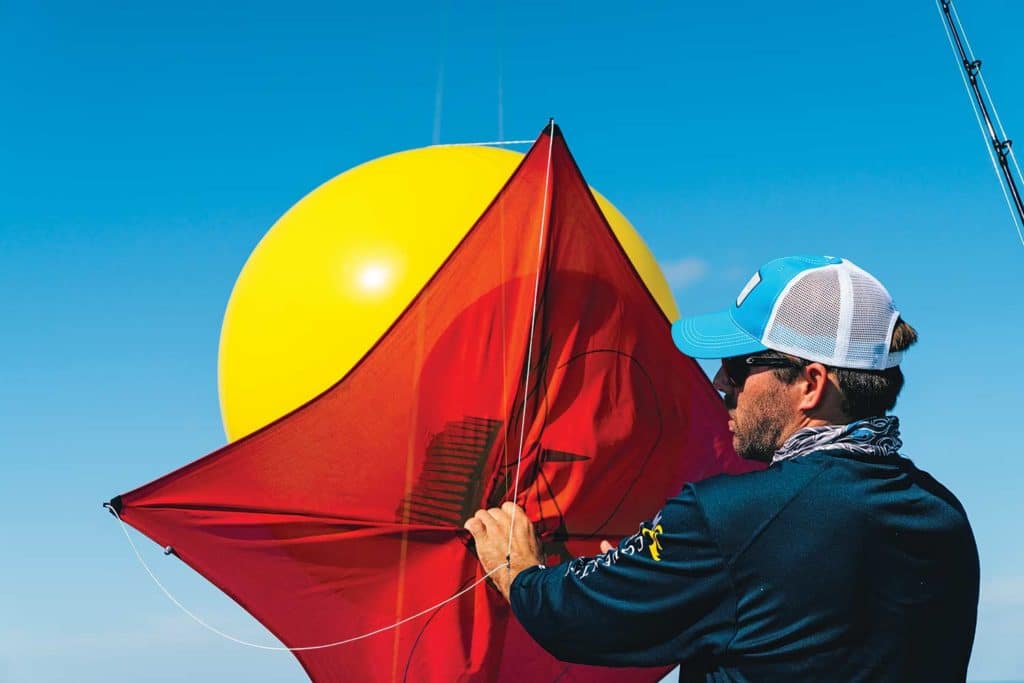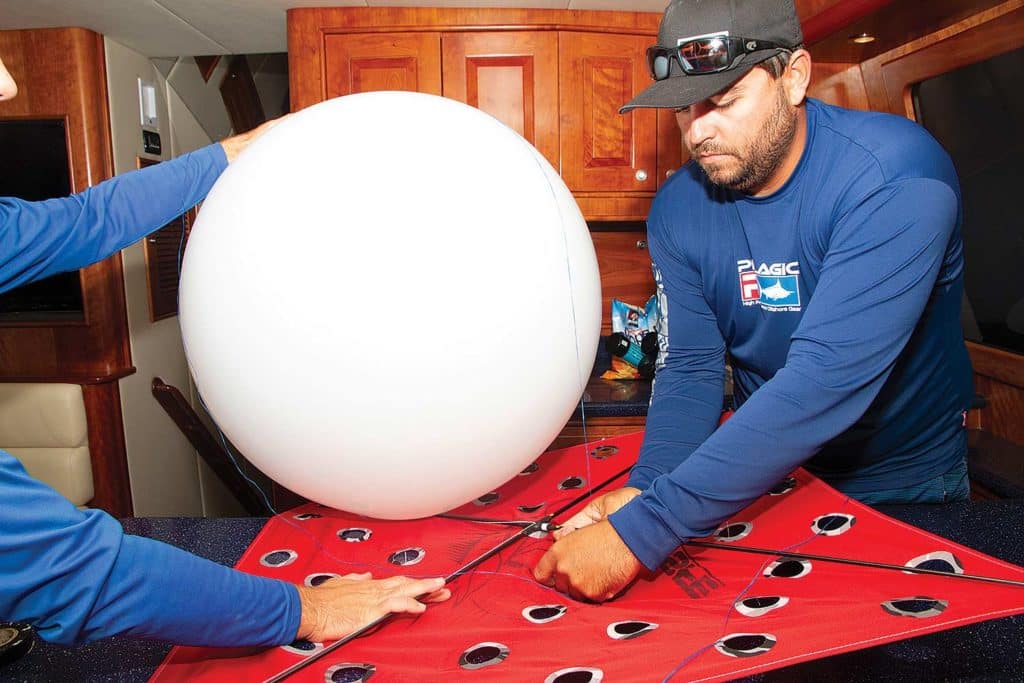
In kite-fishing, there is only one constant: Things are always changing. Moving spots, adjusting tackle, swapping out kites, modifying presentations, and changing out baits. We must be willing to adapt to the conditions du jour, and helium is one of those essential tools we use to change the presentation for surface feeders such as sailfish, which might be on the shy side—or the smart side.
Lighter than Air
Discovered just 150 years ago, helium is a nontoxic gas that is great for filling up balloons at birthday parties, but did you also know that it’s one of the most abundant elements in the universe? Unfortunately, though, it is a nonrenewable resource on our planet, and currently, helium is experiencing yet another worldwide shortage. The gas pockets are formed as a result of the slow radioactive decay of uranium and thorium, and is collected mostly from these pockets. Not only is helium nonrenewable, it is also a rare—and pricey—element, so we hurry up and wait.
When there’s not enough wind to naturally fly your kite, balloons filled with helium will help make your fishing day a go. Much stronger than a standard party model, a kite balloon measures 36 inches and is made of durable latex.
First, you will need to purchase a helium tank. For part-timers, small, single-use disposable tanks found at party-supply stores will do if you’re out for a day or two, but they usually fill up only one and a half 36-inch balloons. For the seasoned teams who fish more often, a larger, refillable tank is a must.
Depending on the size of the tank, you might be able to fill six to eight kite balloons from one tank. Carrying at least two of these larger helium tanks during tournaments—space permitting—is worth considering, just in case you encounter any unforeseen kite-mares, or if the valve is accidentally left on and the gas seeps out.
Watch: Check out this sailfish swimming in a residential canal in Naples, Florida.
Get Rigged
Once you have the balloon inflated to the correct size for the conditions, there are a few different ways you can rig it; attaching the balloon to one of the kite’s spars is first. The general rule is this: Attach the balloon on the opposite side of the direction you want the kite to fly. If you want the kite to go right, attach it to the top left spar, and vice versa.
Sometimes just tying it on is enough, or you can spike the tied balloon end to one of the spars and slide it into position. There is also the option of using a kite thong: a small bridle system made of swivels and floss that attaches to the kite spars and is easily adjusted by moving the balloon to different positions.
Or you can use the old-school method of tying the balloon to the kite’s center where the spars attach. With this method, you floss the bottom of the spar, run a long piece over top of the balloon, and secure it snuggly to the top spar of the opposite corner. Once the balloon is in place, a few small pieces of painter’s tape will hold the floss in place on the balloon. Painter’s tape works the best because it is more forgiving on the balloon should you need to remove it to make adjustments.

Cut to the Chase
Once the balloon is attached, add weight to the opposite side. Split-shot leads work great for lining the side of the kite, but you can also use a small egg sinker attached to a spar with some copper rigging wire.
Adjusting, adding or removing leads to different areas on the kite’s edge will affect how it flies outward—or cuts—from the center of your spread; bridle adjustments on the front will affect how high the kite flies. When fishing in helium conditions, you will want the bridle set almost all the way toward the kite. The farther toward the kite you adjust the bridle, the lower it should want to fly, and vice versa.
If the wind is especially light, it might be necessary to scale back your kite’s main line and terminal tackle. I get away with 30-pound-test braid by incorporating small 50- to 80-pound Spro swivels, or even a dropper loop on the main line instead of flossed stoppers, which weigh down the line. The lower your kite line bellies toward the water, the less effective your spread becomes. Anything less than 15 feet above the surface—the length of your leaders—and the entire process falls apart.
By adding a small piece of copper rigging wire to each drop loop or swivel in place of a Black’s clip to hold each bait in position, you are able to fish in near-calm wind conditions. And as the wind dies, every little bit of weight off the kite line can keep your baits fishing.
Read Next: Learn the basics of kite-fishing along with a few insider pro tips here.
Using 40-Hole Kites
Although typical wind gusts last less than 20 seconds, when you’re trying to get bit, or worse, you’re already in a bite, these unpredictable breezes can wreak havoc on your spread. When the wind gusts—anywhere from 9 to 16 knots over the mean wind speed—the kite has a momentary freakout. As it catches the gust, the kite will suddenly rise, pulling the baits up and out of the water with them. And if there is a hungry sailfish checking out your offerings and his meal suddenly disappears, then so does he. No bueno.
If the wind is blowing on the verge of being just enough for light-wind kites but maybe too much for helium, or when the wind is gusting, it might be the perfect time to break out the 40-hole kites. The manufacturer—SFE—describes it as a niche kite, able to hold its position in gusty conditions and in winds whipping up to 30 mph; however, it can also be used in both scenarios.
In the borderline wind situation, adding a less-than-maximum-filled helium balloon to a 40-hole kite allows some of the wind to pass through the kite, while added lift from the balloon acts as an insurance policy.
Theoretically, a 40-hole kite, when coupled with a balloon filled with just enough helium to hold the kite in position, is perfect when the wind is blowing between 6 and 12 mph and gusting to 12 to 14 mph; the gusts can pass through the holes, keeping the kite steady and your baits fishing. And if—or rather, when—the wind falls out, which is not uncommon in variable conditions, the helium is there to save your $200 kite.
Kite-fishing with helium is an advanced technique, and although it can be tedious, it is also quite effective. By taking your time, rigging for wind-specific fishing, and anticipating and adjusting for changes in the conditions as the day progresses, your efforts might be rewarded with plenty of bites that you wouldn’t get by sitting at the dock.







